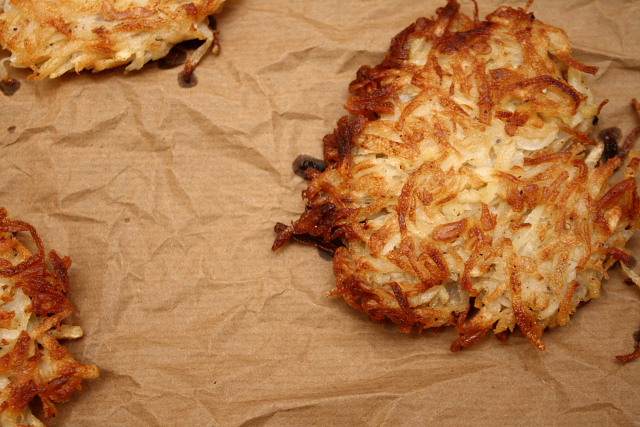There are many variations on this simple pancake-style potato dish, from the Swiss rosti, through Polish and Czech versions, landing on an Israeli interpretation, the latke, a Hanukah staple and speciality.
Latkes are at their best when made and served immediately. Making the mix too far in advance allows the potato to brown and take on an unappetising look, leaving them standing after cooking lets the essential crispness of fried potato slip away. Latkes should be crisp, hot and taken straight from the scorching pan to hot plates and onto a table, with as little waiting around as possible.
This version is a mix of potato and parsnip, a great way of hiding some extra vegetables away from unsuspecting young eyes … the parsnip is indistinguishable to the eye, but adds a subtle flavour and a welcome softness to the finished latke.
The best potatoes to use are Desiree, but anything on the slightly waxy side will do. Floury potatoes will disintegrate too easily, and you’ll be left with cakes of mashed potato. They’ll taste good, but the point will be lost.
Peel the potatoes, about 600g worth, and grate them using the coarse side of a grater. A food processor with a grating disk makes this a doddle.
Rinse the grated potato in a big bowl with plenty of water, and drain it in a colander, pressing out as much water as possible. Spread the grated potato out on a large tea towel and let it dry out completely. It needs to be quite dry.
Peel and grate 300g of parsnips, and put them in a large bowl with the now-dry potato, and add four egg whites, two tablespoons of cornflour, a teaspoon of salt and plenty of ground black pepper. Mix everything together well.
Heat about 50g of vegetable oil and 20g of butter over a medium high heat in a large frying pan, and when it’s hot, form a latke from about two tablespoons, or a small handful, of the mixture. Squeeze the mixture hard in your hands to get rid of as much liquid as possible – there will be quite a bit, and form it into a patty about eight centimetres wide and one centimetre thick, and carefully place as many as possible into the pan without overcrowding it. I managed four.
Let the latkes fry for three or four minutes, turn them over and cook for a similar length of time. They should be uniformly brown.
Drain on kitchen paper and serve straight away as a side dish.
Sour cream to dollop on top is a good idea.
This recipe is from Yotam Ottolenghi and Sami Tamimi’s brilliant Jerusalem, but there’s another version with a few variations in Claudia Roden’s wonderful The Book of Jewish Food: An Odyssey from Samarkand and Vilna to the Present Day
.

